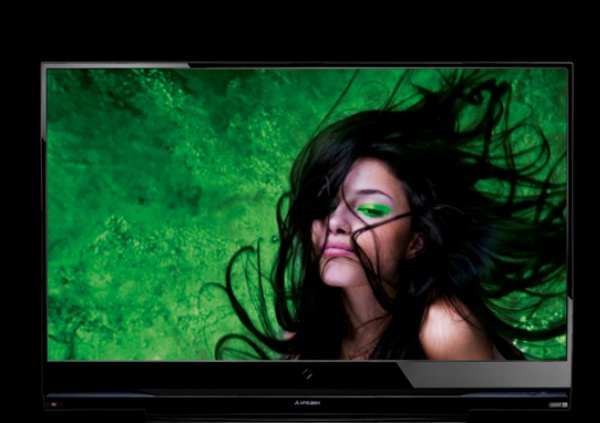Blu-ray Disc Player & DLP High-Definition TV OPPO BDP-83 & Mitsubishi WD-73835
- 31 Oct 2009 08:13
- 392

OPPO Digital, Inc., 2629 Terminal Boulevard, Suite B, Mountain View, CA 94043. Voice: (650) 961-1118. Fax: (650) 961-1119. E-mail: service@oppodigital.com. Web: www.oppodigital.com. BDP-83 Blu-ray Disc Player, $499.00 (direct from manufacturer). Review sample originally on loan from manufacturer, later acquired by The Audio Critic.

Mitsubishi Digital Electronics America, Inc., 9351 Jeronimo Road, Irvine, CA 92618-1904. Voice: (800) 332-2119. E-mail: MDEAservice@mdea.com. Web: www.mitsubishi-tv.com. Diamond WD-73835 DLP high-definition 73-inch TV, $4699.00 (original list price—large retail discounts available). Review sample originally on loan from manufacturer, later acquired by The Audio Critic.
High-definition video has become an inevitable sequel and companion to high-quality audio. It is impossible to be heavily involved with the latter without being at least somewhat involved with the former. To me, as a reviewer, that presents a problem. I am equipped to review audio components objectively, with measurements, but when it comes to TV I am basically in the same boat with all the subjective reviewers I want to distance myself from. I have no laboratory instruments for measuring video, just a few test discs for the visual evaluation of test patterns, color bars, etc. These can’t separate the performance of the disc player and of the TV monitor; the two must be connected and viewed as a single unit. I simply can’t compete with the likes of Joe Kane (he’s Mr. Video himself, the techno guru of Joe Kane Productions), but I would still like to report my experiences with an unusually high-quality and cost-effective video setup I recently acquired. Call me a closet subjectivist if you think I have betrayed my objectivist principles. It’s only TV, after all.
The Blu-ray Player
The BDP-83 is obtainable directly from the OPPO Digital company, without the in-between step of a retail outlet. If that were not the case, the price would probably be around $1000 instead of $499, and even that would be a bargain. I really don’t know what one of those multithousand-dollar players can do that the BDP-83 can’t. In circuitry and construction, the BDP-83 is a high-end product, regardless of its price. You don’t ask what features it has; it’s much simpler to ask what it doesn’t: no HD DVD playback (they’re history, in any case)—and that’s it. This is about as “universal” as a disc player can get. For a detailed list of its stupefying range of features and capabilities, go to http://www.oppodigital.com/blu-ray-bdp-83/; I see no reason to repeat what is available with a click of the mouse. It takes a 74-page user manual to cover all the bells and whistles, so don’t expect an exegesis here.
I did not measure the audio output of the BDP-83, even though I have the instrumentation to do it. The DACs and op-amps in the current generation of digital audio products are good enough to make it a meaningless exercise, except perhaps at the junk level. Minuscule differences in measured performance are strictly academic as far as sound quality is concerned. I was really interested only in video performance, where fairly large differences still exist.
The 73-Inch DLP Television
I cut through the maze of claims for the various competing HD video technologies—DLP, LCD, plasma, LED, etc.—by applying the following criterion: which of them would allow me to have a huge screen at a less than exorbitant price? The answer: only DLP. I want to watch baseball and football on the largest screen available, because it’s more like being there; a 73-incher is about the minimum that satisfies me. I actually switched to the 73-inch DLP from a 100-inch projection screen and an LCD projector; the small loss in screen area was more than made up for by the vastly brighter picture.
DLP is a projection technology (in this case rear projection) that uses an optical semiconductor chip containing an array of millions of microscopic mirrors. You’ve seen the TV commercial; a young girl with a nasal New York accent (maybe she’s the client’s niece) exclaims: “It’s amazing! It’s the mirrors!” I’m not saying DLP is either superior or inferior to all the competing technologies. It’s just that the Diamond Series WD-73835 happened to be Mitsubishi’s top-of-the-line DLP rear-projection set when I acquired it, and it was more affordable than the largest plasma or LCD sets. You can buy it these days for around $2000 from many of the standard Internet sources. It’s not nearly as flat as the plasma and LCD sets; the projection mechanism bulges out in the rear; but I had no intention to mount it on the wall in any case.
Again I refer you to http://www.mitsubishi-tv.com/pdf/WD73835_specsheet.pdf for the technical details; no need to be redundant. The owner’s guide is 88 pages long; it’s also downloadable from mitsubishi-tv.com if you really want to get involved (I didn’t think so…). The point is that there are more features, settings, adjustments, bells and whistles than can be even briefly summarized here.
The Video Experience
This is really the only reason I am posting this review—to tell audio people who don’t pay too much attention to video that there is extreme high-fidelity TV available at a price well below the insanity level.
The picture I am getting with this equipment is incredibly lifelike. The resolution is 1080i on HD channels via Verizon FiOS (not available everywhere but the best provider where it is) and 1080p with Blu-ray DVDs played on the OPPO BDP-83 through its HDMI output into the TV’s HDMI input. I cannot say that 1080p is vastly superior to 1080i because even the latter is breathtakingly real when the transmission is faultless. You can count each hair in the stubble on the pitcher’s chin; you can see the threads in the buttons on somebody’s suit. The colors are extremely vivid but still quite natural in the default mode, and best of all the picture remains very bright in a well-lit room. With Blu-ray at 1080p turn the same observations up a notch; the small details aren’t really crisper, just more fine-grained, more natural; indeed, the whole presentation is more natural, more film-like, more convincing in the gradations of color. It’s a truly beautiful picture. Visitors who haven’t been exposed to really good high-definition TV totally flip out when they see it. One has to remember that the same total number of pixels fill the 73-inch screen as would fill a smaller screen, but the coarsening magnification isn’t great enough to affect the perceived resolution from a normal viewing distance.
Just for the hell of it, I inserted a test DVD in the BDP-83. It was the “Spears & Munsil High-Definition Benchmark, Blu-ray Edition.” I had no intention to do any serious tweaking because I was deliriously happy with the default settings. The color adjustments were so numerous to begin with as to be overwhelming—forget about it—but the geometrical test patterns were meaningful. Sheer perfection—I’ve never seen such circular circles, such square squares, such absolutely straight lines, such 90° right angles. If something had been askew, I wouldn’t have known whether to blame the disc player or the TV, but everything was right on. It was my only deviation from a 100% subjective review, just to save face.
So there you are, audiophiles. Superspecial HD video for around $2500, total. I need to add that the built-in audio of the Mitsubishi is quite mediocre. An external audio system is recommended. As for the OPPO, its 5.1 and 7.1 audio capabilities are as good as the power amplification and loudspeakers you end up using with it. The line-level audio processing is not the issue, as I’ve already said.
